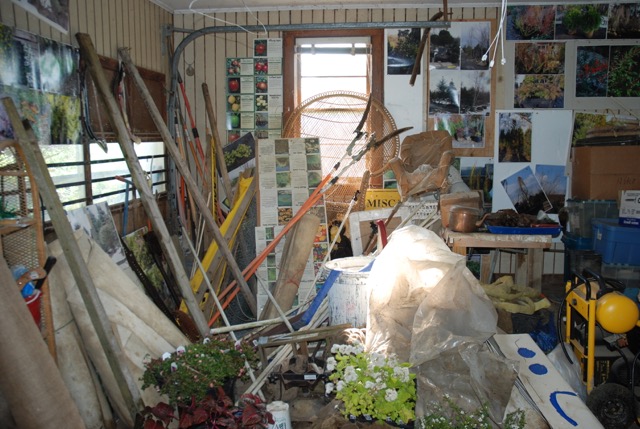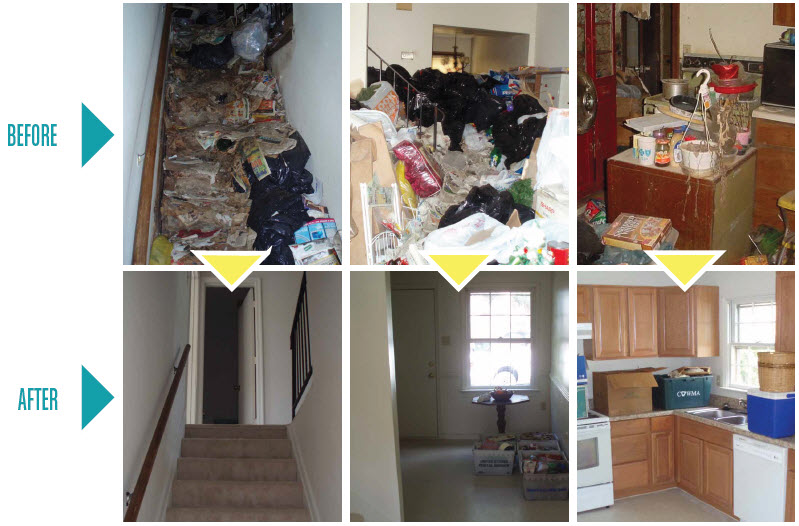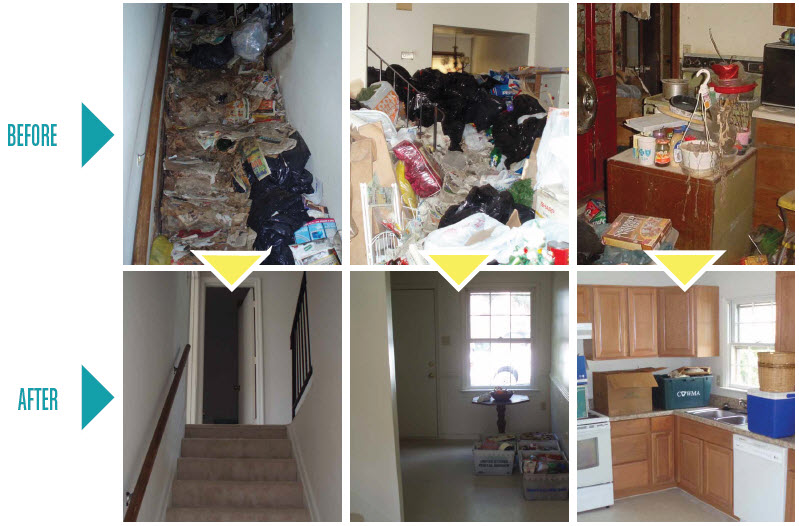Hoarding – a type of anxiety disorder that prevents the affected individuals from assessing the actual value of an item and making informed decisions about their possessions and their own lives – has been a growing concern in the United States over the last several decades.
Hoarders accumulate large amounts of worthless items and get emotionally attached to them, without being able to organize their belongings or classify them according to their value. Afraid of losing something important, valuable, or useful, hoarders refuse to throw anything away. As a consequence, the accumulated items grow to monstrous proportions and block off most of the living space in the hoarders’ homes, rendering crucial everyday activities such as cleaning or bathing impossible. This results in poor sanitary conditions, increased fire hazards, and various health risks. To make things even worse, hoarders are usually embarrassed by their problem and avoid all social interaction. They become socially withdrawn, depressed, anxious, and stressed out. Yet, they either don’t realize that they have a problem or refuse to acknowledge it, so they are unlikely to look for help.

It’s up to friends and family members to reach out to loved ones struggling with hoarding disorder and help them resume a normal life. Removing the hoard and cleaning the hoarder’s home, however, is not enough.
Helping a hoarder overcome their anxieties and regain control over their lives is a delicate and complicated process that requires a lot of patience and compassion. It involves several crucial steps – establishing mutual trust, providing effective counseling and treatment, restoring the hoarder’s house to safe and healthy living conditions, and helping the hoarder maintain a clean and tidy home.
Provide Emotional Support
If you want to help a hoarder, you need to earn their trust. Being judgmental and condemning won’t get you anywhere. The only way to make the affected person understand the severity of the problem and get motivated for change is to show respect, empathy, and genuine concern:
- Listen to what your friend or relative has to say and try to understand their reasons for accumulating and keeping worthless items. Hoarding is usually triggered by a stressful or traumatic experience – the loss of a loved one or a serious disruption of the person’s normal lifestyle. If this is the case, you can help the hoarder let go of the past (and all the items associated with it) by showing them that they are not alone, that there are still people who care about them, that life is worth struggling for, (in other words – by offering your support and friendship). Dealing with the root causes of the hoarding behavior will allow the affected person to overcome the problem and get their life back on track;
- Let your friend or relative know that you care for them – invite them over for dinner, go out together as often as possible, bring them small gifts (useful ones) and find other little ways to show kindness and friendship. Remind the affected person that hoarding is just an issue they are struggling with, not their entire identity or way of life;
- Highlight the dangers and drawbacks of hoarding. Explain to your friend or family member that hoarding causes severe risks to their health and safety because of the excessive accumulation of dust and dirt in the house, probable mold and bacteria growth among the large piles of junk, pest infestation (clutter provides perfect breeding habitat and hiding places for all kinds of insects, rodents, and other pests), increased fire hazards as a result of the large amounts of flammable materials in the home, and blocked access to emergency exits and other important parts of the house. Apart from the poor sanitary conditions in the hoarder’s home, hoarding can lead to social isolation, disruption of relationships, legal and financial issues, and other similar problems. If your loved one understands this, they may be more willing to reconsider their situation and accept help.
Assist Recovery
No matter how simple the solution may seem to you – discard the junk and clean the home – a hoarder will not see it this way. If you remove the hoard and have the house cleaned, the affected person will most likely experience serious emotional distress and will see you as a thief and an evildoer. They will no longer trust you, will not accept the forced remedy, and will just start accumulating stuff again. You can’t force your loved one to get better – you need to find a way to make them want to get better.
1) Offer your personal assistance and suggest a therapy
Let your friend or relative know that if they are willing to struggle for a change, you will be there for them whenever they need you – to listen to them, to keep them company, to help them sort out and organize their belongings, to lend them a hand with cleaning, etc. Assure them that you won’t betray their trust, won’t sneak into their home and take their possessions away, won’t force them into treatment, or do anything else against their will.
Yet, ask your friend or relative to consider professional assistance as therapy may help them overcome their anxieties and restore their self-esteem and self-confidence more easily. Taking the first step toward hoarding treatment can be daunting and your loved one may be embarrassed to talk to a stranger about such a personal matter, but professional treatment offers the most efficient and beneficial form of help for hoarders – affected individuals tend to respond well to Cognitive Behavioral Therapy, certain medications yield very good results, hoarders support groups have proven to be very helpful during the recovery process, etc. Therefore, you are strongly recommended to research treatment options, consult mental health professionals, and attend support groups in order to find a qualified therapist (psychologist or psychiatrist) who will be able to help your loved one deal with the root causes of the problem and reduce hoarding behavior.
2) Help your friend or relative understand value
As already mentioned, hoarders cannot tell the difference between valuable and worthless. They believe that each and every item in their possession has a great sentimental, practical, or intrinsic value. Getting the affected individual to understand the true value of the items they are hoarding will allow them to reassess the situation and overcome their attachment to worthless objects. So, find the time to go through all the items in your loved one’s hoard together with them and try to convince the affected person that most of the articles hold no monetary or practical value whatsoever. Ask them to keep only the items that can be used in everyday life and those that elicit a strong emotional response and give away (donate or dispose of) everything else.
Do not force your friend or relative to throw away an object they are not ready to part with. Back off for a while when you feel your loved one is too overwhelmed, give them plenty of time to make their decisions, allow them to act at their own pace – this slow, patient approach will help the affected individual “help themselves” and is certain to have lasting results.
3) Help your loved one sort out their possessions
To help your friend or relative make informed decisions about the fate of their belongings, you can make a list of criteria for keeping or discarding items:
- Keep objects that are frequently needed, expensive items, family heirlooms and other articles that hold special sentimental value or can be used in daily life;
- Let go of anything that is damaged, outdated, or no-longer needed.
Ask the affected person to sort all their possessions into several categories (“keep”, “donate”, “trash”) based on the above criteria. If your loved one has difficulty making a final decision, you may add another category – “store for the time being” – as well. (It is advisable to preserve all the items your friend or relative is not ready to part with yet – otherwise the stress may turn out to be too much for the affected individual and all progress may be lost. Just make sure these objects are stored out of the way).
You may assist your loved one with helpful questions and guidance while they’re sorting their possessions but you should never do the sorting for them – they need to make their own decisions themselves. This will give them some feeling of control and will help them overcome their indecisiveness and procrastination.
4) Provide initiatives
Find some simple, compelling reasons for your loved one to clear out some of the clutter – suggest preparing dinner together (to motivate your friend or relative to remove all the items from the kitchen table and the stove), watching a movie on the TV in the evening (so that they clear the sofa of stuff), etc. Such small practical initiatives will help your loved one realize that clutter is preventing them from having a comfortable life and will stimulate them to take action and improve the situation.
Restore The Good Condition of the Hoarder’s Home
Once you have convinced your loved one to let go of their useless possessions, the actual cleaning process may finally begin. Just be careful not to go too far, too quickly – do not try to clean out the entire house in a couple of days. It may take the hoarder months or even years to get rid of the accumulated items and restore a normal lifestyle. So, be patient and take one small step at a time:
- Start with an area of the house that is least likely to present emotional challenges, such as the bathroom – get rid of anything stored in it (there will be no valuable or sentimental items in the bathroom) and sanitize the surfaces, so that the room becomes suitable for its intended purpose;
- Clear out the most essential parts of the home – the areas around the bed, the table, the stove, the fridge, the washing machine, the sofa, etc. Remove all the junk from over and around those essential household items, so that the affected person can use them freely and resume normal everyday activities, such as cooking, washing, etc.;
- Set small, doable goals – make sure the magnitude of the task does not overwhelm the affected individual (decluttering and cleaning one shelf, or cabinet, or drawer is more than enough for one day). What matters is to be consistent;
- Recognize small victories – your loved one needs to know that even the smallest “victories” matter, so that they have incentive to keep trying. So, find ways to reward your friend or relative for every success – praise them for throwing away certain items (as well as for not adding to the hoard), take “before and after” pictures which will give them a real sense of pride as they progress, engage them in some entertaining activities that were impossible until now because of the lack of free space, etc.;
- Seek professional assistance – hoarding cleanup is a time-consuming and physically- and emotionally-draining process. If you are not up to the challenge, or if the situation is too severe, consider hiring ServiceMaster Disaster Restoration and Recovery for professional hoarding cleaning services in the Bay Area. Our experienced specialists will not only dispose of unwanted items and thoroughly clean and disinfect the premises (as well as any salvaged items) but will also help reorganize the home and make it safe, comfortable, and cozy.

Help Your Loved One Maintain a Clean and Tidy Home
Once the hoarder’s house is restored to a safe and sanitary condition, you need to make sure it will stay this way:
- Help your friend or relative resist the temptation of acquiring new items – prevent them from going on shopping sprees, express doubt about the usefulness or necessity of an object they want to obtain, have them put any items they insist on having on a “wish-list” and wait for at least a month before buying them (your loved one will most likely lose the urge to buy the article over that period), convince your friend or family member to make place for any new item by losing an old one, etc.;
- Provide your loved one with an easy-to-follow cleaning and maintenance plan and check on them regularly to make sure they stick to it;
- Provide continued support to your loved one to prevent hoarding problems in the future.
Cleaning out a hoarder’s home can be a dangerous job so make sure to contact our professionals for hoarding cleaning services. We have the training and equipment to clean and restore the homes of hoarders safely. You can reach us at (800) 439-8833 for hoarding cleaning in San Francisco, CA and the surrounding communities of the Bay Area.
Hoarding estimates – Get a Quote Online

Steve VanDenBerg is the owner of ServiceMaster Disaster Restoration and Recovery. He has over 30 years of experience working within the restoration industry and successfully leading start-ups, turnarounds, acquisitions and mergers, and rapidly growing companies.
Steve earned his BS in Business & Accounting from Calvin University in Grand Rapids, MI and began working for DSI Holdings as their Chief Financial Officer. When Steve began with DSI Holdings, they were running an underperforming ServiceMaster Restore franchise with one location. Steve implemented new policies and procedures for accounting and finance as well as a professional sales plan that increased profits eightfold over his time as the CFO. He was then promoted to President and CEO and in this time, he expanded the company from two locations with $4M in sales to 12 locations and $45M in sales. DSI Holdings became one of the largest disaster restoration companies in the U.S. and helped with major restoration projects throughout the U.S. and around the world.
Steve purchased ServiceMaster DRR in 2015 when the business was in decline. Drawing on his years of experience in turning around struggling ServiceMaster franchises, Steve overhauled our operations, including finance, sales, and marketing, which led to a quick turnaround. Within Steve’s first 24 months, sales increased by 60 percent. Steve also helped greatly improve our operating margins and established a relationship with California’s largest residential insurance company. Under Steve’s leadership, we have become one of the largest disaster restoration providers in California.
Steve has found great success in turning around struggling and stagnant restoration franchises by changing the business model and strategy, greatly increasing sales and profits. Many of the changes he has implemented have even been adopted by the franchisor into their operating model.



